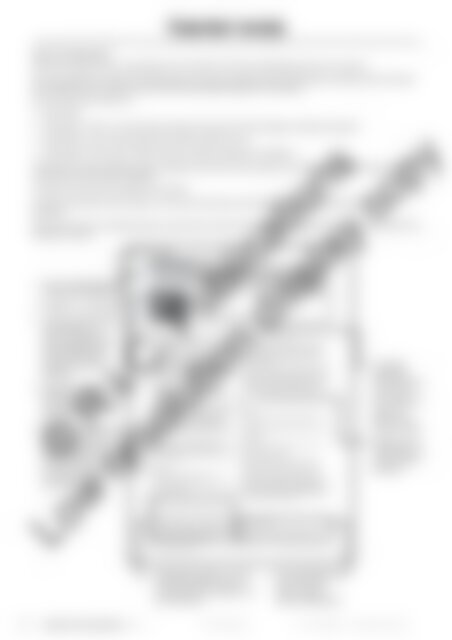8561RB AC Science Year 6 revised edition LR watermark
You also want an ePaper? Increase the reach of your titles
YUMPU automatically turns print PDFs into web optimized ePapers that Google loves.
Teacher notes<br />
How to use this book<br />
Each book is divided into units corresponding to the sub-strands of the <strong>Science</strong> understanding strand of the curriculum.<br />
Each unit is divided into a number of four-page lessons, each covering a particular aspect and following a consistent format. The lessons<br />
are numbered for ease of reference and can be followed sequentially, although it is not essential.<br />
Each four-page lesson consists of a:<br />
• teacher page<br />
• student page 1, which is a science literacy text about the concept, with relevant diagrams, images and questions<br />
• student page 2, which contains questions and activities related to the text<br />
• student page 3, which involves a hands-on activity, usually an experiment or investigation.<br />
The <strong>Science</strong> as a human endeavour strand is integrated into the lessons where possible, and is listed in the Content focus box, at the top<br />
of each lesson’s teacher page (if applicable).<br />
The <strong>Science</strong> inquiry strand is integrated into all lessons.<br />
The scope and sequence charts on pages x and xi show all the strands, sub-strands and content descriptions covered in each of<br />
the lessons.<br />
At the end of each unit, an assessment page is provided, which relates to the achievement standards for that sub-strand, as set out by the<br />
Australian Curriculum.<br />
• <strong>Science</strong> understanding<br />
sub-strand name/unit title.<br />
• Lesson title.<br />
• A brief description of the<br />
Content focus for the<br />
lesson, the <strong>Science</strong> as a<br />
human endeavour substrand<br />
and the science<br />
inquiry skills used in<br />
the lesson.<br />
• Background information,<br />
relevant to the lesson or<br />
the topic, is provided for<br />
the teacher.<br />
• Preparation required by<br />
the teacher is listed. This<br />
could include guidance for<br />
locating websites, online<br />
resources, books, or a list<br />
of equipment required for<br />
the hands-on activity.<br />
Earth and space sciences<br />
Can scientists cooperate in space research?<br />
Content focus:<br />
The International Space Station (ISS)<br />
<strong>Science</strong> as a<br />
Nature and development of science<br />
human endeavour:<br />
<strong>Science</strong> inquiry:<br />
Lesson 5<br />
Processing, modelling and analysing | Communicating<br />
Background information<br />
The lesson<br />
• The ‘space race’ became a way for countries to exert their • Pages 45 and 46 are to be used together.<br />
supremacy over others, especially during the Cold War, when<br />
• Allow the students to read the text on page 45 independently.<br />
they did not physically fight each other.<br />
Assist them with any unfamiliar vocabulary such as ‘milestones’,<br />
• The European Union is an economic and political union of 27 ‘trusses’, ‘modules’, ‘arrays’, ‘biology’, ‘chemistry’, ‘physiology’,<br />
(as of 2022) member states located in Europe. Its members ‘physics’ and ‘meteorology’. If necessary, then discuss the<br />
are Austria, Belgium, Bulgaria, Croatia, Cyprus, Czech<br />
information and concepts.<br />
Republic, Denmark, Estonia, Finland, France, Germany,<br />
• To complete the research activity on page 47, students will need to<br />
Greece, Hungary, Italy, Latvia, Lithuania, Luxembourg, Malta,<br />
navigate the NASA, International Space Station website, and search<br />
Netherlands, Poland, Portugal, Republic of Ireland, Romania,<br />
through the topic of Research and technology. Students could also<br />
Slovakia, Slovenia, Spain and Sweden.<br />
design their own research rather than using page 47, if there is<br />
• Data from the crew of the space station is sent daily to a topic about the International Space Station that they find more<br />
scientists on Earth. Experiments are conducted each day interesting, such as ‘15 benefits of Space Station Research’.<br />
and can be modified easily. The findings are published<br />
each month.<br />
Answers<br />
• Research on the space station includes finding out about the<br />
Page 46<br />
long-term effects of space habitation on the body (relating<br />
to bone loss and muscle wasting), how to provide medical 1. People’s Republic of China, the European Union, Japan, India,<br />
care in space, what effect near-weightlessness has on USA, Russia<br />
the internal processes of plants and animals, how protein<br />
2. the high cost of building a space station by individual nations<br />
crystals are formed in space, fluid investigations, and<br />
knowledge about combustion which may affect energy use 3. The components of the space station are launched into space on<br />
on Earth.<br />
board spacecraft.<br />
• Microgravity is a state in which gravity is reduced to almost 4. 20 solar panels<br />
non-existent levels, such as during a space flight.<br />
5. laboratories, docking ports, nodes (connecting passageways),<br />
• Students can get updated information about activities on the airlocks, living quarters, robotic arms<br />
ISS by looking at NASA’s International Space Station website 6. NASA, ESA, Roscosmos, JAXA, CSA<br />
or social media pages.<br />
7. The crew fly missions, conduct experiments and repair and<br />
Preparation<br />
replace parts of the space station. They also do educational<br />
demonstrations, such as experiments for students on Earth.<br />
• It will be beneficial to explore and become familiar with<br />
NASA’s International Space Station website.<br />
8. Answers will vary but might include that the space station will<br />
provide a base for excursions to objects in space further from<br />
• Access to a dictionary may be useful to assist students with Earth; it may help to reduce the risks involved in space exploration<br />
any unfamiliar vocabulary.<br />
by being able to repair spacecraft in space rather than having to<br />
return to Earth; it will provide knowledge about how space travel<br />
affects humans and therefore make it safer.<br />
Do your students require an extension task?<br />
Consider asking students to find out about space technology<br />
which has been adapted for use in everyday life, such as:<br />
mattress materials; satellite television; satellite imaging for<br />
weather forecasts; virtual reality; water purification systems;<br />
baby food; athletic shoes; scratch-resistant lenses; solar<br />
energy; the cochlear implant; digital cameras.<br />
Measure in a minute<br />
Ask students to explain to a partner what they think is the most<br />
important reason for the existence of the International Space<br />
Station.<br />
44 Australian Curriculum <strong>Science</strong> (<strong>Year</strong> 6) 978-1-923005-13-6 R.I.C. Publications ® ricpublications.com.au<br />
• The lesson<br />
instructions;<br />
these could relate<br />
to the literacy<br />
text, the question<br />
page or the<br />
delivery of the<br />
hands-on activity.<br />
• Answers for the<br />
student pages are<br />
provided, where<br />
applicable.<br />
© R.I.C. Publications<br />
Low resolution display copy<br />
• Ponder point suggestion, to assist<br />
with differentiating the lesson or<br />
ensuring inclusion. See page viii for<br />
more information.<br />
• Quick assessment<br />
option for after the<br />
lesson, to gauge<br />
student understanding.<br />
vi Australian Curriculum <strong>Science</strong> (<strong>Year</strong> 6) 978-1-923005-13-6 R.I.C. Publications ® ricpublications.com.au

















